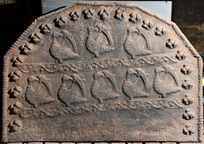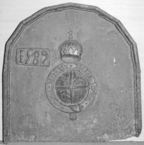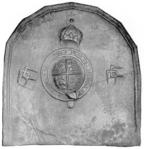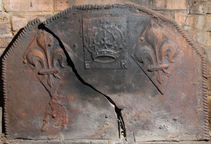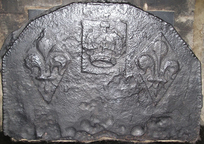-
1201
Description: Rectangular with five-facetted arched shape; twisted rope edging (top and sides); small flower-bud stamp repeated 23 times inside the edging; across the middle of the fireback, two approximately parallel lines of lengths of vine strip moulding inclined up to the right; between them, five bird stamps, probably swans (a Lancastrian badge), the front of their left wings 'displayed and inverted', and three more swans above the top line of vine strip moulding.
Notes: The stamps are all seen on other firebacks in the same series. The five-facetted arch is seemingly unique. A very similar fireback with minor differences was lot 2630 at Toovey's auction, Washington, West Sussex, 19 Jun 2015.
Copies of this fireback are known.
- Decoration tags:
- multi-facet arched (shape)
- rope (edging)
- carved stamps
- animals
- objects
Manufactured: in the late-16th century possibly at Pounsley Furnace, Framfield in the Weald area of England.
Current location: in private hands, Chiddingstone, Kent, England.
- Attached to series:
- Pounsley series
- Swan series
- Vine strip series
-
52
Description: Arch-shaped, the arch consisting of eight, straight, ovolo-moulded sections; longer ovolo-moulded pieces form the lower sides of the fireback; in the centre a circular garter enclosing the Tudor arms of England; above, a crown; the date was carved on a single stamp and placed left of the crown.
Notes: From other examples it is apparent that the crown is formed from a separate stamp to the shield and garter. Formerly at Knole, Sevenoaks, and later at Horton Court Lodge, Monks Horton, Kent.
Copies of this fireback are known.
Inscription: 1589 / HONI SOIT qVI MAL I PANSE
Arms: Tudor royal
- Decoration tags:
- multi-facet arched (shape)
- ovolo (edging)
- carved stamps
- date stamp
- armorial
- royal
- text
Manufactured: in 1589 possibly in the Weald area of England.
Current location: Dartford Museum, Dartford, Kent, England.
Museum number: 1938-141 (part of the Dartford Museum museum group)
- Attached to series:
- 1589 series
- Tudor royal armorial firebacks
-
266
Description: Arch-shaped, the arch consisting of eight, straight, ovolo-moulded sections; longer ovolo-moulded pieces form the lower sides of the fireback; in the centre a circular garter enclosing the Tudor arms of England; above, a crown; irregularly spaced each side of the shield, a crossed staple stamp (the left one over-pressed).
Notes: The crossed staple stamp suggests a connection with the Nevill family. The crown is formed from a separate stamp to the shield and garter. Other variants are dated 1589. Recorded at Penshurst Place in 1903; illustration from Dawson 1903.
Inscription: HONI SOIT qVI MAL I PANSE
Arms: Tudor royal
- Decoration tags:
- multi-facet arched (shape)
- ovolo (edging)
- carved stamps
- heraldic
- armorial
- royal
Manufactured: in the late-16th century in the Weald area of England.
Current location: not known.
Citation: Dawson, C., 1903, 'Sussex Iron Work and Pottery', Sussex Archaeological Collections, 46, pp. 1-54.
Citation: Gardner, J. S., 1898, 'Iron Casting in the Weald', Archaeologia, 56, 1, pp. 133-164.
- Attached to series:
- 1589 series
- Tudor royal armorial firebacks
-
295
Description: Five-facetted arched shape; ovolo-moulded edging comprising two separate lengths of moulding repeated to form sides and arch; shield of Hickman (per pale indented argent and azure) impaling Nevile (?gules a saltire argent) within repeated laurel leaves inside a scrolled cartouche; date top centre.
Notes: William Hickman of Old Hall, Gainsborough, 2nd Baronet (1629-82), married Elizabeth Neville of Mattersey, Nottinghamshire, c.1652. The multi-facetted arch calls to mind a series of firebacks cast in the Weald which are also associated with the Nevills (see 1589 series), although they are of earlier date.
Inscription: 1658
Arms: Hickman impaling Neville; Sir William Hickman
- Decoration tags:
- multi-facet arched (shape)
- ovolo (edging)
- whole carved pattern
- individual numbers
- armorial
- text
Manufactured: in 1658 in England.
Current location: Gainsborough Old Hall, Gainsborough, Lincolnshire, England.
(part of the English Heritage museum group)
- Attached to series:
- Personal armorial firebacks
-
486
Description: Rectangular with 5-facetted arch; twisted rope edging; centre top, rectangular stamp, over-pressed, with crown above initials in bottom corners; diamond shaped stamp with fleur-de-lys repeated each side of crown, both over-pressed; spillage blemish below left fleur.
Notes: Notable for the large size of the fleur-de-lys stamp; this casting differs from another (no. 1164) in the placement of the stamps.
Inscription: E R
- Decoration tags:
- multi-facet arched (shape)
- rope (edging)
- carved stamps
- heraldic
- royal
- objects
Manufactured: in the mid- to late-16th century in the Weald area of England.
Current location: in private hands, Mayfield, East Sussex, England.
- Attached to series:
- Large diamond fleur series
- Fleur-de-lys firebacks
-
1164
Description: Rectangular with 5-facetted arch; twisted rope edging; centre top, rectangular stamp, over-pressed, with crown above initials in bottom corners; diamond shaped stamp with fleur-de-lys repeated each side of crown, both over-pressed.
Notes: Notable for the large size of the fleur-de-lys stamp; this casting differs from another (no. 486) in the placement of the stamps. Formerly at Parsonage Farm, Steeple Bumpstead, Essex.
Inscription: E R
- Decoration tags:
- multi-facet arched (shape)
- rope (edging)
- simple stamps
- carved stamps
- heraldic
- royal
- text
- objects
Manufactured: in the mid- to late-16th century in the Weald area of England.
Current location: in private hands, Newmarket, Suffolk, England.
- Attached to series:
- Large diamond fleur series
- Fleur-de-lys firebacks
